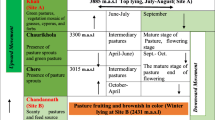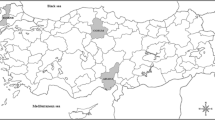Abstract
The efficiency of sheep is dependent on their health and well-being. The blood markers can be critical for improving of the physiological, nutritional and pathological status of sheep organism. The aim of this study was to test the hypotheses that the red and white blood cells and copper (Cu) and zinc (Zn) plasma contents are impacted by altitude and season. The ewes were kept at three farms. Blood samples were divided according to factors of altitude (550 m, 800 m, 950 m above sea level), season (spring, fall) and year. The lowest haemoglobin concentration and value of haematocrit were detected at the altitude of 550 m (66.95 g L−1, 0.36 L L−1) and the highest at the altitude of 950 m (117.96 g L−1, 0.39 L L−1) (P < 0.001). Spring values of haemoglobin and haematocrit were lower than fall values. The highest count of leucocytes was recorded at the altitude 950 m (9.57 G L−1), higher counts were contained in spring (P < 0.001). The lowest percentage of eosinophiles was found at the altitude of 800 m (5.81%) and the highest at the altitude of 550 m (9.26%) (P < 0.01). Phagocytose activities were the highest at the altitude of 950 m (95.07%) and the lowest at the altitude of 550 m (85.04%) (P < 0.001). Phagocytose activities were higher in fall than in spring. The highest Cu concentration was found at the altitude of 550 m and the lowest at the altitude of 800 m (17.04 μmol L−1 vs. 14.37 μmol L−1). Zn levels were higher at altitudes of 950 m and 800 m than at the altitude of 550 m (17.81 μmol L−1, 17.00 μmol L−1 vs. 14.77 μmol L−1). We concluded that hematological markers and trace mineral content in grazed sheep may be impacted by altitude and season.
Similar content being viewed by others
References
Anonymous. 2008. STATISTIX 9 for Windows. User’s Manual. Analytical Software, Tallahasee, FL, USA, ISBN 978-1-881789-07-9, 454 pp.
Bires J., Bartko P. & Huska M. 1997. Distribution of risk elements in the organism of sheep after industrial intoxication with zinc. Spectrosc. Lett. 30: 1263–1277.
Čermák B., Lád F., Klimeš F., Jílek R. & Kobeš M. 2006. Dynamic of nutrients quality characteristic of pasture in different altitude in South Bohemian region. Slovak J. Anim. Sci. 39: 99–102.
Dacie J.V. 1991. Practical Hematology. 7th Ed. Churchill Livingstone. London, England, 556 pp.
Frelich J., Pecharová E., Klimeš F., Šlachta M., Hakrová P. & Zdražil M. 2006. Landscape management by means of cattle pasturage in the submountain area of the Czech Republic. Ekológia (Bratislava) 25(Suppl. 3): 115–123.
Herrera E.A., Pulgar V.M., Riquelme R.A., Sanhueza E.M., Reyes V.R., Ebensperger G., Parer J.T., Valdez E.A., Giussani D.A., Blanco C.E., Hanson M.A. & Llanos A.J. 2007. High altitude chronic hypoxia during gestation and after birth modifies cardiovascular responses in newborn sheep. Am. J. Physiol. Regul. Integr. Comp. Physiol. 292: 2234–2240.
Jančová A., Massányi P., Nađ P., Koréneková B., Skalická M., Drábeková J. & Baláž I. 2006. Accumulation of heavy metals in selected organs of yellow-necked mouse (Apodemus flavicollis). Ekológia (Bratislava) 25: 19–26.
Jelinek P., Gajdusek S. & Illek J. 1996. Relationship between selected indicators of milk and blood in sheep. Small Ruminant Research 20: 53–57.
Jessen T.H., Weber R.E., Fermi G., Tameo J. & Braunitzer G. 1991. Adaptation of bird hemoglobins to high altitudes: Demonstration of molecular mechanism by protein engineering. Proc. Natl. Acad. Sci. USA. 88: 6519–6522.
Kellogg D.W., Socha M.T., Tomlinson D.J. & Johnson A.B. 2003. Effect of feeding a combination of cobalt glucoheptonate and metal specific amino acid complexes of zinc, manganese and copper on lactation and reproductive performance of dairy cows: eight-trial summary. Prof. Anim. Sci. 19: 1–9.
Kellogg D.W., Tomlinson D.J., Socha M.T. & Johnson A.B. 2004. Effect of feeding zinc methionine complex on milk production and somatic cell count of dairy cattle: twelve-trial summary. Prof. Anim. Sci. 20: 295–301.
Kottferova J. & Korenekova B. 1995. The effect of emissions on heavy metals concentrations in cattle from the area of an industrial plant in Slovakia. Arch. Environ. Contam. Toxicol. 29: 400–405.
Kottferova J. & Korenekova B. 1997. Comparison of the occurrence of risk elements in bulls and dairy cows coming from the fallout region of a metallurgical plant on the territory of Slovakia. Arch. Tierz. 40: 309–316.
Laven R.A. & Smith S.L. 2008. Copper deficiency in sheep: An assessment of the relationship between concentrations of copper in serum and plasma. New Zealand Vet. J. 56: 334–338.
Leeson S. 2009. Copper metabolism and dietary needs. World’s Poultry Science Journal 65: 353–366. DOI: 10.1017/S0043933909000269
Lominadze D., Saari J.T., Percival S.S. & Schuschke D.A. 2004. Proinflammatory effects of copper deficiency on neutrophils and lung endothelial cells. Immunol. Cell Biol. 82: 231–238.
Lopez A.M., Benedito J.L., Miranda M., Castillo C., Hernandez J. & Shore R.F. 2000. Arsenic, cadmium, lead, copper and zinc in cattle from Galicia, NW Spain. Science Total Environ. 246: 237–248.
Massanyi P., Nad P., Toman R. & Kovacik J. 2001. Concentrations of cadmium, lead, nickel, copper and zinc in various muscles of sheep. Die Bodenkultur 52: 255–258.
Massanyi P., Trandzik J., Nad P., Korenekova B. & Skalicka M. 2003a. Concentration of copper, iron, zinc, cadmium, lead and nickel in boar semen and relation to the spermatozoa quality. J. Environ. Sci. Health A Tox. Hazard Subst. Environ. Eng. 38: 2643–2651.
Massanyi P., Trandzik J., Nad P., Toman R., Skalicka M. & Korenekova B. 2003b. Seminal concentrations of trace elements in various animals and their correlations. Asian J. Androl. 5: 101–104.
Nutrient Requirements of Sheep. 1985. Sixth Revised Edition. Subcommittee on Sheep Nutrition, Committee on Animal Nutrition, Board on Agriculture, National Research Council. National academy press, Washington, D.C., 112 pp.
Orden E.A., Serra A.B., Serra S.D., Nakamura K., Cruz L.C. & Fujihara T. 2000. Direct effects of copper and selenium supplementation and its subsequent effects on other plasma minerals, body weight and hematocrit count of grazing Philippine goats. Asian-Aust. J. Anim. Sci. 13: 323–328.
Rajčáková L., Gallo M., & Milynár R. 2003. Cummulation of copper, zinc, lead and cadmium in grass with high imission load and its effect on the production of grass mass. Slovak J. Anim. Sci. 36: 221–227.
Sahin K., Sahin N., Kucuk O., Hayirli A. & Prasad A.S. 2009. Role of dietary zinc in heat-stressed poultry: A review. Poultry Science 88: 2176–2183. DOI: 10.3382/ps.2008-00560
Slavik P., Illek J. & Zeleny T. 2006. Zinc and copper status of beef cattle in the Sumava region, Czech Republic. Acta Vet. Brno. 75: 485–488.
Solaiman S.G., Craig Jr. T.J., Reddy G. & Shoemaker C.E. 2007. Effect of high levels of Cu supplement on growth performance, rumen fermentation, and immune responses in goat kids. Small Ruminant Research. 69: 115–123.
Solaiman S.G., Shoemaker C.E. & Andrea G.H.D. 2006a. The effect of high dietary Cu on health, growth performance, and Cu status in young goats. Small Ruminant Research. 66: 85–91.
Solaiman S.G., Shoemaker C.E., Jones W.R. & Kerth C.R. 2006b. The effects of high levels of supplemental copper on the serum lipid profile, carcass traits, and carcass composition of goat kids. J. Anim. Sci. 84: 171–177.
Sommer A., Ceresnakova Z. & Frydrych O. 1994. Nutrient requirement and nutrients value of feeds for cattle, sheep and goats. Publication of VUZV Nitra, 1st issue, Nitra, Slovakia, 116 pp.
Storz J.F. & Moriyama H. 2008. Mechanisms of hemoglobin adaptation. High Altitude Medicine and Biology. 9: 148–157.
Swenson M.J. & Reece W.O. 2004. Duke’s Physiology of Domestic Animals. Twelfth Edition, William Reece W. (ed.), Cornell University Press, Comstock Publishing Associates. Ithaca, New York, U.S.A., 962 pp.
Šrejberová P., Šoch M. & Brouček J. 2008. Relationship between copper and zinc on selected haematological parameters in beef and dairy cattle. Slovak J. Anim. Sci. 41: 42–45.
Tripathi M.K., Mondal D. & Karim S.A. 2008. Growth, haematology, blood constituents and immunological status of lambs fed graded levels of animal feed grade damaged wheat as substitute of maize. J. Anim. Physiol. Anim. Nutr. (Berl.) 92: 75–85.
Weber R.E. 2007. High-altitude adaptations in vertebrate hemoglobins. Respir. Physiol. Neurobiol. 158: 132–142.
Author information
Authors and Affiliations
Corresponding author
Rights and permissions
About this article
Cite this article
Šoch, M., Brouček, J. & Šrejberová, P. Hematology and blood microelements of sheep in south Bohemia. Biologia 66, 181–186 (2011). https://doi.org/10.2478/s11756-010-0150-3
Received:
Accepted:
Published:
Issue Date:
DOI: https://doi.org/10.2478/s11756-010-0150-3




